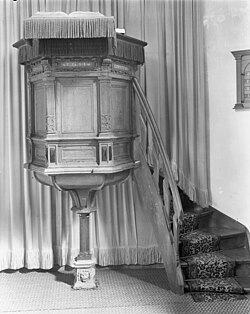Difference between revisions of "Kampen (Overijssel, Netherlands)"
| [checked revision] | [checked revision] |
m |
m |
||
| Line 1: | Line 1: | ||
__FORCETOC__ | __FORCETOC__ | ||
__TOC__ | __TOC__ | ||
| − | [[File:KampenOverijssel.jpg| | + | [[File:KampenOverijssel.jpg|240px|thumbnail|left|''Kampen, Overijssel, Netherlands.<br /> |
Source: [https://en.wikipedia.org/wiki/Kampen,_Overijssel Wikipedia Commons]''.]] | Source: [https://en.wikipedia.org/wiki/Kampen,_Overijssel Wikipedia Commons]''.]] | ||
{| class="wikitable" style="float: right;" | {| class="wikitable" style="float: right;" | ||
|- | |- | ||
| − | | [[File:KampenDoopsgezindekerk.jpg| | + | | [[File:KampenDoopsgezindekerk.jpg|230px|thumbnail|right|''Doopsgezinde Kerk, Kampen.<br /> |
Photo by AFiermas.<br /> | Photo by AFiermas.<br /> | ||
Source: [http://commons.wikimedia.org/wiki/File:KampenDoopsgezindekerk.jpg Wikimedia Commons]''.]] | Source: [http://commons.wikimedia.org/wiki/File:KampenDoopsgezindekerk.jpg Wikimedia Commons]''.]] | ||
Revision as of 23:23, 19 September 2014
Kampen, was a city with a 1947 population of 23,025, with 251 Mennonites in the Dutch province of Overijssel (coordinates: 52.55796, 5.91446 [52° 33′ 28″ N, 5° 54′ 52″ E]. Soon after 1530 there were many Anabaptists here. Since many Flemish fled from their homes for the sake of their faith and settled in Kampen, the church here developed into a flourishing congregation in the second half of the 16th century. Between 1584 and 1620 the government issued a number of public notices against the "secret conventicles of the Anabaptists," thus indicating their numerical strength. Banishment was the penalty for attending their meetings. But on the whole the Kampen authorities were more tolerant toward the Mennonites than toward Remonstrants, Catholics, or Lutherans. In 1625 a notice was posted that Mennonites could be married only in Reformed churches, or the marriage would be considered void. In 1658 this notice was changed to read that the Mennonites could perform their weddings before the mayors. In the meantime (1644) they had furnished a house on Boven-Nieuwstraat as a meetinghouse. It was rebuilt in 1677.
Release from military service met with fewer obstacles here than elsewhere. In 1665 (war with England) the Mennonites were assigned to the extinguishing of fires. Repeatedly the government inquired into the finances of the church.
At the beginning of the 18th century there were in Kampen two congregations, the larger one Flemish (Waterlander), which in 1674 joined the Zonist conference, the other Groningen Old Flemish. In 1711 a new congregation was formed by a number of Swiss refugees (others at Groningen, Sappemeer, and Deventer). Not only because of the language, but also because of the strict discipline of the Swiss Mennonites, they wanted their own organization. The Swiss Mennonites (86 persons arrived here on 24 August 1711, most of whom were farmers living near Kampen) at first held their meetings in the homes of the members, but in 1768 they acquired a meetinghouse Achter de Nieuwe Muren in town. Their elders were Daniel Ricken 1712-1736, Jacob Staalen (Stähly) 1736-1757, Peter Teune (Thöne) 1736-1763, Hans Hupster 1769-1792, and Jan Jans Hoosen of Giethoorn 1805-1822. The Old Flemish congregation, which had only 23 male members in 1710, was soon dissolved, and in 1767 had only a few members left. In 1781 these joined the Flemish. The Swiss church, though it had at first been strengthened by many new arrivals, gradually declined, and in 1822 the 25.remaining members joined the other congregation. After the merger the Nieuwestraat meetinghouse was too small; therefore a new church in the Broederstraat was rented in 1823, and purchased in 1847. This church was still in use by the congregation in 1957. It is a historic building, erected about 1480. Until the Reformation it had been the chapel of St. Anna convent and later a Walloon Reformed Church. The congregation possesses two beautiful engraved silver communion cups from the 18th century. Its pulpit, kept from the Walloon church, dates back to 1611.
The membership numbered 104 in 1834, 110 in 1861, 173 in 1900 and 127 in 1956. From the mid-1800s to the 1950s the congregation was served by the following ministers: J. Sybrandi 1851-1886, H. Ens 1886-1909, Corn. Vis Jzn 1909-1930, F. van der Wissel 1932-1937, A. F. L. van Dijk 1938-1947, Miss H. C. Leignes Bakhoven 1947- . The church activities included Sunday school for the children, and a ladies' circle.
Bibliography
Doopsgezind Jaarboekje (1840): 44; (1850): 37-39.
Doopsgezinde Bijdragen (1875): 57; (1881): 78-105; (1882): 117.
Hege, Christian and Christian Neff. Mennonitisches Lexikon, 4 vols. Frankfurt & Weierhof: Hege; Karlsruhe: Schneider, 1913-1967: v. II, 455 f.
Hoop Scheffer, Jacob Gijsbert de. Inventaris der Archiefstukken berustende bij de Vereenigde Doopsgezinde Gemeente to Amsterdam. Amsterdam: Uitgegeven en ten geschenke aangeboden door den Kerkeraad dier Gemeente, 1883-1884: I, Nos. 69, 84, 147, 267, 886, 1180, 1225, 1350, 1366, 1903-1920; II, Nos. 2016-2031; II, 2 No. 223.
Huizinga, J. Stamboek van Samuel Peter (Meihuizen) en Barbara Fry. Groningen, 1890: 65-68 and throughout.
Map
Map:Kampen, Overijssel, Netherlands
| Author(s) | Nanne van der Zijpp |
|---|---|
| Date Published | 1957 |
Cite This Article
MLA style
Zijpp, Nanne van der. "Kampen (Overijssel, Netherlands)." Global Anabaptist Mennonite Encyclopedia Online. 1957. Web. 25 Nov 2024. https://gameo.org/index.php?title=Kampen_(Overijssel,_Netherlands)&oldid=124896.
APA style
Zijpp, Nanne van der. (1957). Kampen (Overijssel, Netherlands). Global Anabaptist Mennonite Encyclopedia Online. Retrieved 25 November 2024, from https://gameo.org/index.php?title=Kampen_(Overijssel,_Netherlands)&oldid=124896.
Adapted by permission of Herald Press, Harrisonburg, Virginia, from Mennonite Encyclopedia, Vol. 3, pp. 141-142. All rights reserved.
©1996-2024 by the Global Anabaptist Mennonite Encyclopedia Online. All rights reserved.




